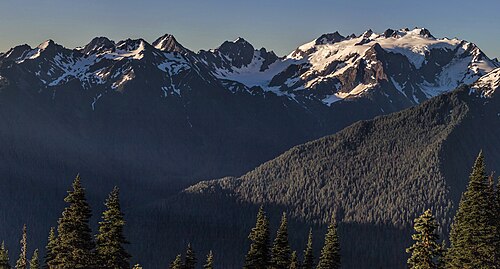geo.wikisort.org - Mountains
Mount Mathias is a 7,156-foot (2,181-metre) mountain summit located within Olympic National Park in Jefferson County of Washington state.[4] Its nearest higher neighbor is Mount Olympus, 1.76 mi (2.83 km) to the east.[1] Mount Mathias is wedged between the massive Blue Glacier below its west slope, and the Hoh Glacier on the east side. Precipitation runoff from the mountain drains into the Hoh River.
| Mount Mathias | |
|---|---|
 Mt. Mathias, from NNW | |
| Highest point | |
| Elevation | 7,156 ft (2,181 m)[1] |
| Prominence | 996 ft (304 m)[1] |
| Parent peak | Mount Olympus (7,980 ft)[1] |
| Isolation | 0.97 mi (1.56 km)[2] |
| Coordinates | 47°48′18″N 123°40′37″W[1] |
| Geography | |
| Location | Olympic National Park Jefferson County, Washington, US |
| Parent range | Olympic Mountains |
| Topo map | USGS Mount Olympus |
| Geology | |
| Age of rock | Eocene |
| Climbing | |
| First ascent | 1957 by [3] |
| Easiest route | class 4 climbing via West Face[3] |
History
This mountain was originally named "Apollo", for one of the Olympian deities in Greek and Roman mythology who made Mount Olympus home.[5] It was renamed in honor of Francis Wayland "Matt" Mathias (1884–1959), a mountaineer, naturalist, and Grays Harbor County civic leader.[5] The Mathias name was officially adopted in 1960 by the U.S. Board on Geographic Names.[4]
The first ascent of this peak was made in 1957 by Yves Eriksson and Jim Hawkins.[3]
Climate

Based on the Köppen climate classification, Mount Mathias is located in the marine west coast climate zone of western North America.[6] Most weather fronts originate in the Pacific Ocean, and travel northeast toward the Olympic Mountains. As fronts approach, they are forced upward by the peaks of the Olympic Range, causing them to drop their moisture in the form of rain or snowfall (Orographic lift). As a result, the Olympics experience high precipitation, especially during the winter months. During winter months, weather is usually cloudy, but due to high pressure systems over the Pacific Ocean that intensify during summer months, there is often little or no cloud cover during the summer. The months July through September offer the most favorable weather for viewing or climbing this peak.
Geology
The Olympic Mountains are composed of obducted clastic wedge material and oceanic crust, primarily Eocene sandstone, turbidite, and basaltic oceanic crust.[7] The mountains were sculpted during the Pleistocene era by erosion and glaciers advancing and retreating multiple times.

See also
- Olympic Mountains
- Geology of the Pacific Northwest
References
- "Mount Mathias". Peakbagger.com.
- "Mathias, Mount - 7,156' WA". listsofjohn.com. Retrieved 2020-08-23.
- Mount Mathias climbersguideolympics.com
- "Mount Mathias". Geographic Names Information System. United States Geological Survey, United States Department of the Interior. Retrieved 2020-08-24.
- Parratt, Smitty (1984). Gods and Goblins: A Field Guide to Place Names of Olympic National Park (1st ed.).
- Peel, M. C.; Finlayson, B. L.; McMahon, T. A. (2007). "Updated world map of the Köppen−Geiger climate classification". Hydrol. Earth Syst. Sci. 11: 1633–1644. ISSN 1027-5606.
- Alt, D.D.; Hyndman, D.W. (1984). Roadside Geology of Washington. pp. 249–259. ISBN 0-87842-160-2.
External links
- "Olympic National Park". National Park Service.
- Weather forecast: Mount Mathias
Другой контент может иметь иную лицензию. Перед использованием материалов сайта WikiSort.org внимательно изучите правила лицензирования конкретных элементов наполнения сайта.
WikiSort.org - проект по пересортировке и дополнению контента Википедии

